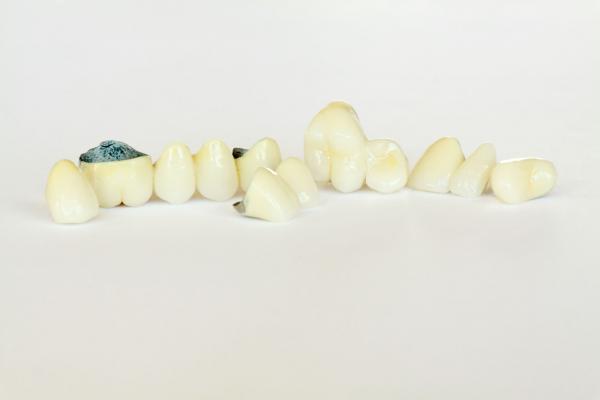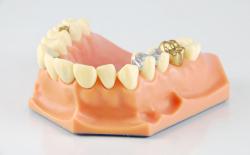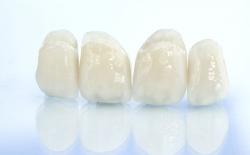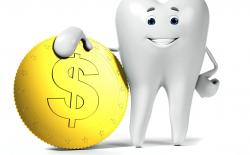What are the advantages of PFM crowns?
PFM crowns are strong and durable
Dentists have been using PFM crowns for more than 35 years.
Even though all-ceramic crowns have better esthetics, PFM crowns are still used, albeit they are not as popular as they used to be.
The reason why PFM crowns might still be preferred is that the underlying metal makes the crown stronger and more stable.
The metal enhances the bonding to the tooth.
They look like your natural teeth
You have a variety of shades to choose from to make it look like your natural teeth. A unique property of porcelain is translucency, which helps to mimic your natural teeth. (Translucency is the phenomenon wherein the light partially passes through the object. Your natural teeth have some amount of translucency.)
They have a very high rate of success in the long run.
The best part of these crowns is the stability and strength which is unmatched by any other restorations available today.
These are best for patients looking for a natural look and durability.
PFM is a preferred choice when bridges for the long run are required and night grinding is a problem.
These crowns are trusted not only by patients but also by doctors all over the globe.
A video about the use cases of PFM crowns. Even though ceramic crowns are getting more and more popular, PFM crowns are still widely used. Duration: 2:32.
Need a local dentist?
What are the disadvantages of porcelain fused to metal crowns?
You lose a lot of your tooth structure
Natural is always the best - the more natural tooth structure you have in your mouth, the better is your oral health.
As PFMs have a metal base underneath, your dentist needs to trim a large part of your tooth to fit them well.
However, if you opt for a gold base underneath the porcelain, your dentist can save more of your tooth.
May cause gingivitis
PFM crowns increase the chances of gingivitis more than the other crown types. However, a gold base is great on your gums, as your body tolerates it well.
(Gingivitis is the inflammation of gums. Redness, swelling, pain, and bleeding are the signs of gingivitis.)
May harm your opposing teeth
When you chew, your teeth in both your jaws, come in contact. Porcelain tends to wear out the opposing teeth in the long run.
They don’t give you a perfect smile
PFM crowns restore your looks but other crowns such as all-ceramic crowns give you a better smile. Over a period of time, the gum line of PFM crowns gets darker.
A grey line appears there which is visible when you smile. This is more true when your gums start going down due to the aging process.
PFMs are not suitable for someone who has receding gums or gums which have gone towards the bone.
The latest technology allows your dentist to opt for a porcelain butt joint margin. This makes sure you don’t see a black gum line even when your gums recede.
May chip off
The porcelain from the PFM crowns can chip off when you bite on very hard foods.
Higher costs
These crowns may be expensive especially when you opt for a metal that is a combination of precious metals.
However, precious metals guarantee better quality. As these crowns stay longer in your mouth, they can be beneficial in the long run.
A short video about porcelain fused to metal crowns. Duration: 1:41.
How much does a PFM crown cost?
The price of a PFM crown is around $1,000 and $1,500 in the US.
However, in the case of porcelain fused to metal crowns an additional reason for the price difference is the metal in the crown.
The metal can be a high noble metal (usually gold), but it can also be a cheaper base metal alloy, like silver, cobalt-chrome, or nickel.
Your best bet is to buy a crown that is fused to gold. This is considered to be the highest quality, even though this is the most expensive option.
As always, there can be huge differences in prices depending on your location, size of the crown, and the experience of the dentists.
It's also good to know that cheaper crowns with nickel might cause allergic reactions in some people.
When comparing quotes from multiple clinics, it's best to ask what metal they use. It's easy to beat the price of porcelain fused to gold crown with a porcelain fused to base alloys one.
You might also want to ask if the clinic uses a local dental lab or imports the crowns - e.g. from China.
Here is a rough estimate of PFM crown prices in various countries:
- United States: $1,000 - $1,500
- United Kingdom: £400 - £500
- Canada: $1,000 - $1,200
- Australia: $1,100 - $1,300
Need a local dentist?
PFM crowns are metal on the inside and porcelain on the outside.

How are porcelain fused to metal crowns made?
Porcelain fused to metal crowns (or PFM crowns) can be referred to as full-cast crowns which have porcelain fused on most or all parts of the metal core of the crown.
They are a hybrid between porcelain and metal crowns. The entire crown has a metal layer underlying and porcelain/ceramic on top of that.
The metal framework is thin, strong, and perfectly fits the prepared tooth. It’s a combination of different types of alloys that are designed so that they bond very well with the porcelain.
Metal alloys with a high melting temperature are used to fuse porcelain to the surface and to prevent the metal from melting. This ensures the porcelain bonds without changing its color.
A porcelain layer is fused over the metal shell. This porcelain layer is 1.5 mm to 2 mm thick depending on the tooth. The porcelain layer is tough, withstands the chewing forces very well, and looks like your natural teeth.
This also means that a large part of the tooth tissue gets removed in order to make space for both the porcelain and the metal.
Types of porcelain fused to metal crowns
The metal framework is a combination of different types of metals. The type of metal is one of the factors which decides the price and quality of your porcelain fused to metal crown.
1. Porcelain fused to base metal alloys
As the name suggests, this framework uses a combination of base metals which are popular in dentistry.
However, some of you may have an allergy to a few of the base metals such as nickel. Opting for noble metal crowns helps you avoid allergic reactions.
2. Porcelain fused to titanium alloys
Titanium alloys have the properties of noble metals such as gold.
As they have superior properties they are useful for implants and other dental prostheses.
Porcelain fused to titanium alloys carry better properties than base metal alloys but gold alloys are even better.
3. Porcelain fused to gold alloys
Gold alloys offer the best properties, carry the highest strength, durability, and cause no allergy.
Though the name says gold, a gold alloy is a combination of gold, platinum, silver, palladium, copper, and tin. The first four metals in a gold alloy are known as noble metals as they have superior properties. The last two metals are known as base metals.
The higher the amount of noble metals in a gold alloy, the higher is the price and the better its properties are.
Generally, dental gold alloys carry 16 karat gold, thus, gold restorations used in dentistry also carry a resale value. The composition of gold alloys varies based on the use.
PFM crowns, gold inlays, and gold crowns/bridges carry a different composition based on the properties needed.
- If the gold alloy is used under the porcelain layer, most of the time, gold is 40% of the crown, other precious metals such as platinum, silver, and palladium are 20%, and base metals make 40% of the crown. We call this type of PFM crown the porcelain fused to high noble metal crown.
- Sometimes your crown may be having more than 25% of noble metals and the rest is base metals. We call this porcelain fused to noble metal crown.
- The base metal crowns may also have some amount of noble metals in them.
Gold does not corrode, does not cause allergy, bonds very well with your tooth, and lasts longer.
A major advantage of a gold base is that a thinner crown can be prepared, this helps to preserve your natural tooth structure. Thickness doesn’t decide the strength for gold.
You can skip the black gum line if you use a gold alloy for PFM crowns.
A short before-after video of front teeth restoration with PFM crowns. Ceramic crowns are more common nowadays for front teeth, but PFM crowns also can have nice esthetics. Duration: 0:52.
Captek: a high quality porcelain fused to gold crown
The last few years have seen a lot of advancement in the field of porcelain fused to metal crowns. Patients with all-porcelain crowns are getting theirs replaced with these ones. The latest type of Captek crowns has also done away with the black line that becomes visible around the patient's gum line.
How does the procedure look like?
The process of preparing the porcelain fused to metal crown is similar to other crowns.
Your dentist examines your mouth, gives anesthesia, prepares your tooth, takes an impression, and designs a crown.
Your dentist ensures that the porcelain fuses to the metal which melts at a higher temperature for making your PFM crowns; thus, PFM crowns don’t melt in your mouth or change their fittings when you have hot or very hot foods.
This property of metals used for making the crown also ensures that porcelain keeps its natural color when we fuse it to the metals when making PFM crowns.
The porcelain layer has variations, it can be either:
- Full veneer: It covers all the surfaces of your tooth or
- Partial veneer: It covers only the front surface or the visible surface of your tooth. Here the rest of the surface that covers your tooth is metallic.
How to take care of your PFM crowns?
Avoid biting very hard foods with your PFM crowns. The porcelain layer may chip off. No matter how good porcelain is, it’s not as good as your natural teeth.
Remember to brush twice a day, floss every day, and clean your tongue regularly to keep your mouth healthy.
Frequently Asked Questions
Are porcelain fused to metal crowns good?
PFM crowns have been the go-to solution for many years, however recently all-ceramic crowns are getting more and more popular.
Ceramic crowns require less tooth reduction, more esthetic, and support better oral hygiene.
PFM crowns can still be a good choice in certain cases. If your dentist recommends porcelain fused to metal crown, go for it. Just make sure that high-noble metal is used.
Do porcelain fused to metal crowns contain mercury?
Unlike fillings, crowns do not contain mercury.
However, base metals - like nickel - can still cause allergic reactions. Precious metals like gold, palladium are highly biocompatible and do not cause such problems.
If you are worried about the metals in a PFM crown, either make sure that high-noble metals are used, or choose a metal-free ceramic restoration.
How long do porcelain fused to metal crowns last?
A good dental lab can manufacture a PFM crown that lasts for decades with proper oral hygiene.
Two common problems with PFM crowns:
- chipping of the porcelain: this is usually caused by eating too hard foods and sub-optimal lab work
- black line at the gumline: this can indicate either cause by low-quality lab work or gum recession
Need a local dentist?
You might also be interested in:
Gold Dental Crowns
Gold dental crowns are the most durable crowns, they often last for a lifetime. Read our article to find out why gold is such great material for dental crowns!
Zirconia Crowns
Nowadays zirconia crowns are often preferred over PFM crowns as they are more esthetic and require less tooth reduction.
Dental Crowns Cost
The price of a dental crown depends on many factors. Read our article to find out more about what affects the cost of a dental crown.


